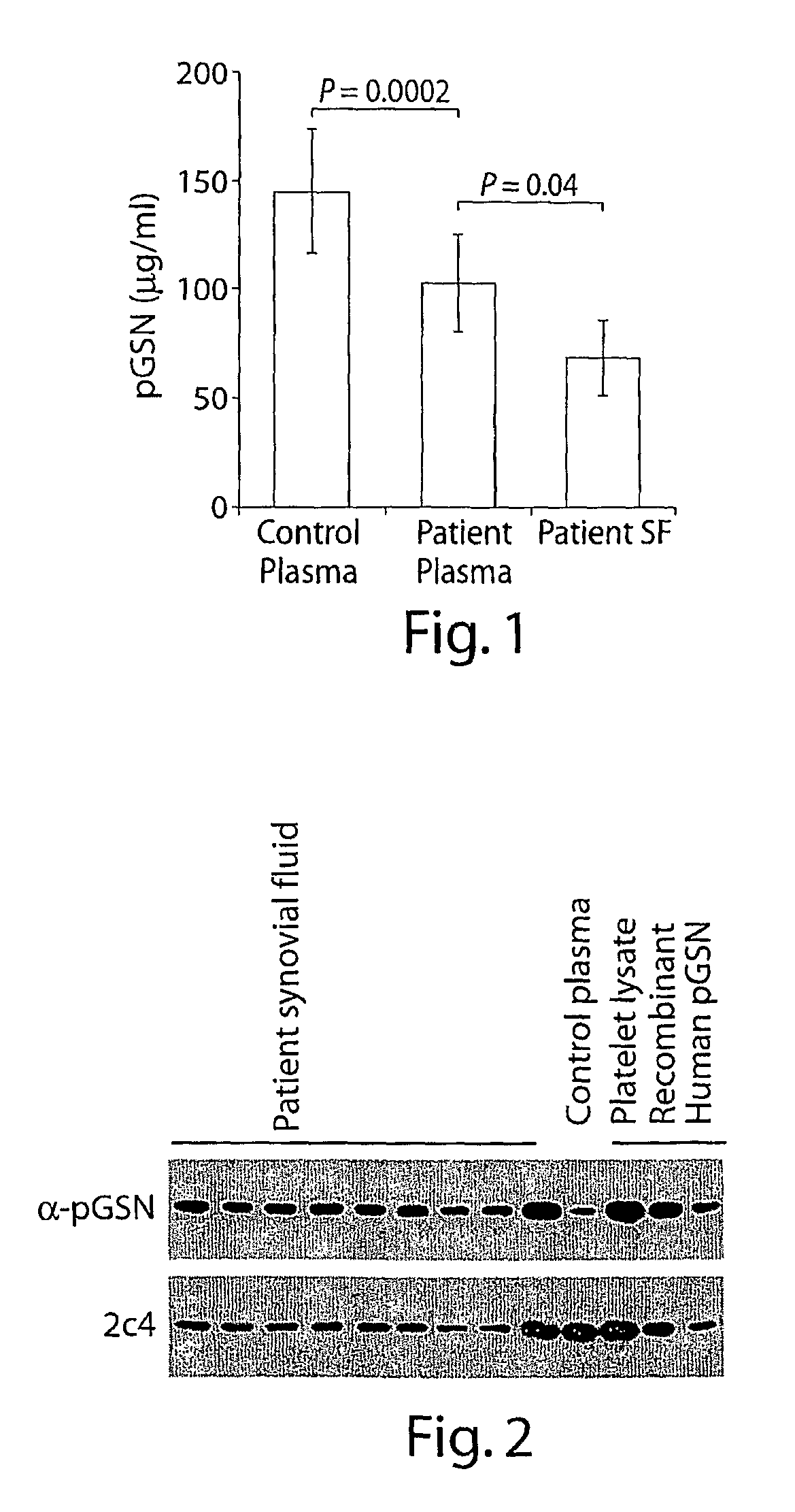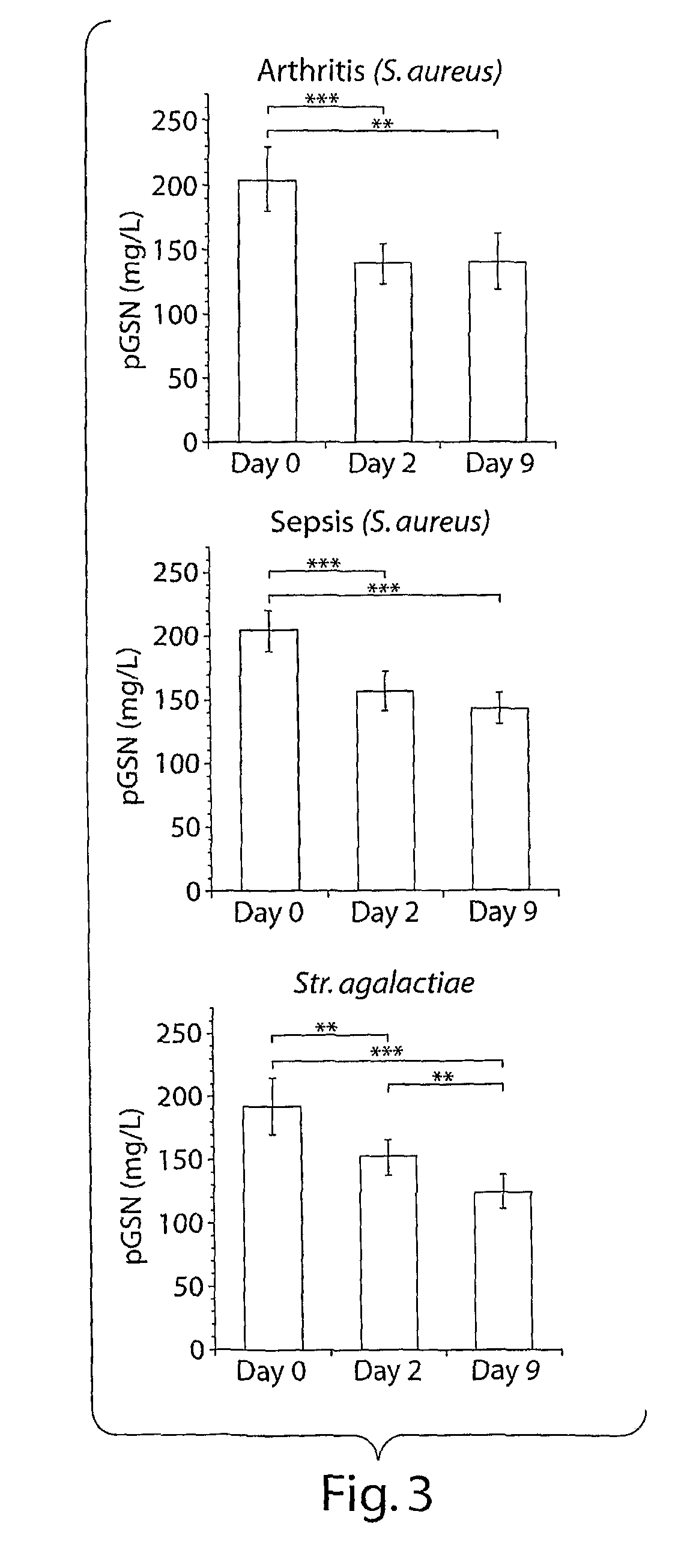Methods of using gelsolin levels to characterize a subject's risk of developing rheumatoid arthritis
a technology of rheumatoid arthritis and gelsolin, which is applied in the direction of immunology, instruments, peptide/protein ingredients, etc., can solve the problems of no cure, no cure, and depletion of plasma gelsolin by injury, and achieve the goal of reducing the risk of subjects, and reducing the risk of inflammatory diseases
- Summary
- Abstract
- Description
- Claims
- Application Information
AI Technical Summary
Benefits of technology
Problems solved by technology
Method used
Image
Examples
example 1
Plasma gelsolin (pGSN) Concentration is Decreased in Patients with Rheumatoid Arthritis (RA) Compared to Healthy Controls and Lower in Synovial Fluid than in Blood in Patients with RA
[0143]We measured plasma gelsolin (pGSN) levels in patients with rheumatoid arthritis (RA) to experimentally test the hypothesis that plasma gelsolin levels fall in response to the initial (unknown) injury inflicted by the agency causing rheumatoid arthritis. As shown in FIG. 1, circulating (pGSN) levels were significantly lower in patients with RA compared to matched healthy controls (103±23 versus 142±29, P=0.0002, FIG. 1). pGSN levels were similar in both male and females, and were not dependent on the age of the patients or on the duration of arthritis. Circulating pGSN levels were inversely correlated to the levels of C-reactive protein (1=-0.272, p=0.026).
Materials and Methods:
[0144]Patients: Plasma and synovial fluid samples were collected from 82 RA patients attending the Rheumatology clinics, a...
example 2
The Gelsolin Isoform Present in Synovial Fluid (SF) of RA Patients is the Plasma Isoform of Gelsolin (pGSN)
[0148]Since gelsolin is produced as both an intracellular and extracellular isoform, each of which have the capacity to induce actin polymerization, we analyzed the origin of the gelsolin activity by immunoblotting with an antibody specific for the plasma isoform (α-pGSN). Gelsolin present in SF is composed mainly of the plasma isoform (FIG. 2). Plasma origin of gelsolin was also supported by a correlation between gelsolin levels in plasma and synovial fluid in the matched pair of samples (r=0.39, p=0.0006). However, pGSN activity in the SF samples from RA patients were significantly lower than that of plasma (pg / ml, 69±18 vs. 103±23, p=0.04) indicating local consumption.
Materials and Methods
[0149]Immunoblotting: The platelet poor plasmas or synovial fluids were diluted 1:100 in 1× sample buffer (SB, 20% glycerol, 4.6% Tris, 0.25 M Tris-HCl, 0.01% Bromphenol blue, 10% v / v 2-Mer...
example 3
pGSN is Decreased at Early Stages of an Experimental Mouse Model of Septic Arthritis / Sepsis
[0151]Levels of circulating pGSN were decreased both during streptococcal and staphylococcal infection. This decrease occurred early during the time course of disease, beginning 2 days post-bacterial inoculation both in arthritic and septic groups of animals. Prior to injection (day 0), the average pGSN level of the mice was 200±20 mg / L. By day 2 pGSN levels decreased to 138±16 mg / L for the arthritic Staphylococcus aureus (S. aureus) treated (7×10^6 cfu / mouse) animals, 157±15 mg / L for the septic S. aureus injected animals (3.5×10^7 cfu / mouse), and 152±15 mg / L for the animals injected with Streptococcus agalactiae (Str. agalactiae) (1×10^7 cfu / mouse). The pGSN levels at day 9 were 141 t 21, 151±15, and 124±13 mg / L, respectively. Only the animals injected with streptococcal bacteria displayed further decrease of the circulating pGSN levels at day 9. pGSN decrease was not related to the intensity...
PUM
| Property | Measurement | Unit |
|---|---|---|
| pH | aaaaa | aaaaa |
| particle size | aaaaa | aaaaa |
| particle size | aaaaa | aaaaa |
Abstract
Description
Claims
Application Information
 Login to View More
Login to View More - R&D
- Intellectual Property
- Life Sciences
- Materials
- Tech Scout
- Unparalleled Data Quality
- Higher Quality Content
- 60% Fewer Hallucinations
Browse by: Latest US Patents, China's latest patents, Technical Efficacy Thesaurus, Application Domain, Technology Topic, Popular Technical Reports.
© 2025 PatSnap. All rights reserved.Legal|Privacy policy|Modern Slavery Act Transparency Statement|Sitemap|About US| Contact US: help@patsnap.com


